Senate
-
- U.S. NAVY SHIP PROCUREMENT Maritime Reporter, Sep 1986 #31
Latest Update As Of August 13, 1986 International Maritime Associates, Inc. publishes quarterly reviews of the Navy ship procurement market. This article is an excerpt from the August quarterly review.
Information in this article is current as of August 13.
SHIPBUILDING AND CONVERSION Exhibit 1 shows the authorization status of the FY 1987 shipbuilding and conversion program now being EDITORS NOTE: This Article is not the full quarterly report. It is an excerpt and represents less than 25 percent of the actual data contained in the complete review.
HOW TO ORDER THE COMPLETE REVIEW Every three months International Maritime Associates, Inc. publishes a detailed review of the U.S. Navy ship procurement market. These quarterly reviews (30+ pages) provide a totally objective assessment of current and prospective Navy business. Both shipbuilding and ship systems/ordnance procurement are addressed. Each review contains a hard hitting assessment of specific programs, lists all major contracts awarded by the Navy, identifies future market opportunities and provides a current directory of key Navy contacts.
More than 220 companies now subscribe to IMA's quarterly market review. The price of a one year subscription is $380. The market review can be ordered by contacting International Maritime Associates, Inc., 3050 K Street N.W., Suite 345, Washington, D.C. 20007, (202) 333-8501 considered by Congress. Figures for FY 1986 and the projection for FY 1988 are provided for comparison purposes. Data for the Senate are final numbers. The House data are based on the House Armed Services Committee recommendations. A House/Senate conference is scheduled for September to iron out differences between the two bills. Appropriation legislation is needed to actually fund the programs.
Significant changes in the program recommended by House and Senate authorizers are described below.
Fast combat ship (AOE)— Citing budget constraints and program priorities, the Senate has deleted the AOE proposed in FY 1987.
Senator Specter (R-Pa.) had planned to introduce an amendment in floor debate which would reverse the committee recommendation and authorize the AOE program.
The amendment was not introduced on the grounds the AOE would be taken up in House/Senate conference. Authorization of this program is recommended by the House committee.
As reported in the previous update, contract design for the AOE was completed last February. Bids are due in October. A contract for four ships (one firm plus three options) has been planned. Program approval is uncertain and a decision must await final outcome of the authorization and appropriation process. Meanwhile, five or six shipyards are preparing proposals.
M i n e s w e e p e r hunter (MSH)—Problems in the MSH program (including shock test failures) resulted in both House and Senate actions to delete proposed FY 1987 funding for these ships.
The Senate authorized the Navy to buy two existing minesweeper hunter ships (one complete ship and one partially outfitted hull) from a shipbuilder in an allied country. This authorization was made subject to the following provision: Funds may not be obligated or expended for the procurement of a lead minesweeper hunter ship or a partially outfitted hull of a minesweeper hunter ship from a foreign country until the Secretary of the Navy has certified to the Congress in writing (A) that purchase of up to two foreignbuilt ships responds to an urgent national security requirement; (B) that no United States shipbuilder has demonstrated the capability, or that no shipbuilder can demonstrate the ability to acquire that capability to meet that requirement in a timely fashion.
In explaining its action the Senate committee stated: Rather than design a wholly new ship, with all the delay and risk that course would entail, the committee recommends the Secretary of the Navy be authorized to use up to $100 million in unobligated prior year funds from the MSH program to acquire a European design capable of meeting our MSH mission. This initiative would add near term minehunting capability to our fleet at a well defined cost and low risk.
The committee expects that follow- on ships of whatever design the Secretary selects will be built in quantity in the United States.
To this end, the committee has recommended bill language authorizing use of prior year funds to acquire a lead ship or parts thereof for completion in the United States. One additional partially outfitted hull may also be procured to facilitate transfer of the manufacturing technology to U.S. shipbuilders.
The committee recognizes the customary prohibition on funding the construction of ships abroad and grants a one time exception for the lead ship and one partial follow hull so that a rapid build up of MSH force levels can be achieved.
Similar language had been drafted by the House committee prior to full committee mark-up.
Efforts by Congressman Davis (RMiss.) succeeded in deleting this language. Instead, the House committee recommends that the Navy convene a NATO study group to assess "ways in which NATO nations can act together to combat the mine warfare threat." The issue of buying existing MSH ships from foreign yards will be taken up in House/Senate conference.
Meanwhile the MSH—which hardly seems like the most complex ship the Navy is acquiring—has been put on ice.
Aegis ships (CG-47 and DDG-51)—The Senate authorized the three DDGs and two CGs requested by the Navy. The House committee recommended two DDGs and three CGs—citing the need to "foster and maintain the existing competitive situation (Ingalls vs.
Bath) and allow the earlier completion of the Navy's 27-cruiser program." An earlier subcommittee recommendation to provide only one DDG in the FY 1987 program was changed in full committee review.
An amendment adopted in House floor action removed the second Aegis destroyer from the House authorization bill. Representative Spratt (D-S.C.) offered this amendment so as to cut obligational authority by $799 million.
As matters now stand the Senate has authorized two CGs and three DDGs as requested by the President.
The House bill will provide authorization for three CGs and one DDG. Differences will be worked out in conference.
The Senate also authorized additional funds ($10 million for design, $18 million for procurement) to provide helicopter support facilities aboard subsequent DDG-51 ships.
This would include the RAST landing system (made by DAF-Indal in Canada) and facilities to arm and refuel helicopters.
Trident submarine—The House committee recommended not authorizing the Trident submarine proposed for FY 1987 funding. It cites budget constraints, pressures on arms control negotiations and lack of competition in Trident procurement.
The Senate has authorized approval of this program for FY 1987. This will be taken up in conference—with approval likely.
Fleet oiler (AO-177) lengthening— Citing cost effectiveness issues, the House committee recommends not proceeding with proposed lengthening of five AO-177 fleet oilers. According to the committee "adding capacity with additional TAO-187 ships would appear to be a less expensive alternative." Additionally, "the at-sea replenishment capabilities of the variant configuration would be greatly hindered by the speed limitations of the AO-177." The Senate has approved this program.
Ocean surveillance ship (TAGOS)—The House committee recommends deleting one TAGOS from the FY 1987 program. Budget constraints are given as the reason for this recommended cut. The Senate has approved the three ships requested.
WEAPONS PROCUREMENT The Navy requested $6.1 billion to buy missiles, torpedoes, mines and other weapons in FY 1987. The House Committee recommended programs totaling $5.9 billion—and an additional $138 million was added by floor amendment. A $5.6- billion program is authorized by the Senate. Details are shown in Exhibit 2.
Rolling airframe missile (RAM)—Both House and Senate committees recommend not authorizing RAM procurement or further development efforts in FY 1987.
The U.S./German program is behind schedule, over cost and said to be "plagued by continuing reliability and quality assurance problems." Reversing the committee recommendation in floor action, the Senate authorized proceeding with the RAM program subject to: • the expectation that Navy would spend up to $24.2 million in RDT&E funds and $40 million in procurement funds for RAM in FY 1987; • the funds must be obtained by taking from other authorized programs GD-Pomona is the prime contactor for RAM. EG&G, Bermite- Whittaker, Hercules, and Morton Thiokol are also involved in this program.
Other missiles—The House committee recommends deleting 224 IIR Maverick missiles and adding 95 Phoenix missiles to the budget request. Hughes-Tucson manufactures both of these missiles.
MK-48 advanced capability (ADCAP) torpedo—Citing delays in testing the House committee recommended cutting FY 1987 ADCAP procurement from 227 to 50 torpedoes. An amendment introduced by Congressman Spratt (DSC) added $253 million back into the MK-48 procurement program.
Hughes-Fullerton is the prime contractor for the ADCAP torpedo.
A n t i - s u r f a c e warfare (ASUW) torpedo—Stating that the projected inventory of MK-48 and MK-48 (ADCAP) will double the current inventory of heavyweight torpedoes, the House committee recommends disapproval of the proposed ASUW torpedo program in FY 1987.
M K - 5 0 advanced lightweight torpedo—The House committee recommends cutting FY 1987 procurement from 84 to 67 MK-50 torpedoes. It cites budget pressures and the desirability of maintaining production over an extended period as the reason for the reduction. Honeywell-Minneapolis is the prime contractor for this program.
MK-60 Captor mine—Last year, the House added 150 Captor mines to the Navy's procurement request. Continuing this directive the House committee recommends $60 million for 130 mines in FY 1987. The Navy has not requested this procurement. Citing the role of Congressman Hartnett of South Carolina, the House committee directs that the Captor mine be renamed the Hartnett mine by the Navy. Goodyear Aerospace in Akron, Ohio is prime contractor for the program.
ELECTRONICS AND SUPPORT EQUIPMENT The Navy requested $6.5 billion for other procurement programs in FY 1987. The House committee recommends $5.8 billion and the Senate has authorized $6.1 billion. Details are given in Exhibit 3.
MK-45 gun mount—The Senate committee recommended against authorizing a multiyear pro- curement contract for MK-45 gun mounts and MK-6 ammo hoists.
FMC-Northern Ordance is involved in this program. Reason given for the recommendation is the savings in long term program costs are "not worth the near term cost in additional outlays." Seasheds—The House committee recommends that 350 seasheds be purchased in FY 1987. The Navy's proposal is to buy 100 seasheds. Two firms qualifying as small businesses have been receiving contracts to supply seasheds to the Navy. The Senate committee expressed concern that the Navy acquisition rates have been unpredictable— adversely affecting these small contractors.
AN/SQR-17A acoustic processor— The Navy had requested funding to procure eight units in FY 1987. The House committee recommends an increase to 20 units. Reason given is more efficient production and quicker delivery which would result.
AN/BLD-I microwave intercept receivers—The House committee recommends adding procurement of eight AN/BLD-I units in FY 1987. Navy had not requested this procurement. Reason given for the recommendation is to encourage more efficient production and quicker delivery.
RESEARCH AND DEVELOPMENT The Navy requested $10.6 billion for RDT&E programs in FY 1987.
The House committee recommends a program totaling $9.1 billion and the Senate authorizes a $9.5-billion program. Details are in Exhibit 4.
Penguin missile—The Senate refused to authorize the Penguin missile program, citing program costs and anticipated marginal benefits: Penguin is a Norwegian designed, infrared homing, anti-ship missile which would provide LAMPS MK-III helicopters with a capability to attack ships and surfaced submarines.
The Committee believes that in today's funding climate, Penguin is a program whose costs ($112.7 million) exceed its marginal benefits.
Integration costs for Penguin have almost doubled ($36.0M to $66.0M) and the entire program will convert only 33 ships and 28 helicopters to employ the missile.
Each ship will store only 4 missiles.
Moreover, each helicopter will carry only one Penguin. That single missile will afford too low a probability of ship kill to warrant risking the helicopter against modern shipboard AAW defenses.
Finally, the FFG-7 class ships scheduled to receive Penguin capable helicopters already have the 60-mile range Harpoon anti-ship missile. Penguin, with its 20-mile range, would only marginally enhance those ships' warfighting capability.
The committee recommends authorization of $3,994 million for the LAMPS program. No funds are provided for Penguin. Remaining funds provided for Penguin should be used for helicopter modifications necessary to accommodate the Mark-50 torpedo.
A news account in Aviation Week & Space Technology predicts congressional approval of Penguin for FY 1987. Involved in this program are Kongsberg Vapenfabrikk in Norway and Grumman Corp.
Rankine Cycle Energy Recovery (RACER) system—The Navy has canceled RACER developed for the DDG-51—a program that has support in the House. The House committee has recommended authorization of $20 million for RACER development, citing the following: The RACER system was intended to complement the LM-2500 propulsion system on the Navy's latest destroyer—the DDG-51 Arleigh Burke Class. It was estimated that RACER would extend the range of these ships by up to 2,000 miles. During the past twoyear period, however, the program has been mismanaged. The Navy did not follow Congressional guidance and, in fact, used funds authorized and appropriated for the RACER program for other purposes. The RACER system tests were suspended by the Navy, and subsequently, the contract for RACER development was canceled.
The committee does not concur in the Navy's action to cancel the RACER program and, accordingly, recommends $20.0 million in authorization to resume testing of the RACER system for deployment on the DDG-51 as well as other platforms. Section 204 would provide that no funds be used for research, development, test and evaluation for the DDG- 51 class ship until the Secretary of the Navy resumes testing of the RACER system and advises the Congress that testing will continue through completion of landbased and at-sea testing. Additionally, the RACER and DDG-51 designs must be compatible.
The Senate accepts the Navy's decision to abandon RACER. Language in the Senate authorization bill eliminates the requirement that the lead DDG-51 be capable of accommodating the RACER system.
Surface ship enhancement— The House committee recommends that the Navy begin a program in FY 1987 to upgrade surface ship sensor and defensive system capability.
It recommends $90 million be authorized for this effort. Of this total $30 million would be for sensors upgrades, $35 million for engagement improvements (e.g. hypervelocity defense missile) and $25 million for anti-air warfare weapon development. This recommendation is one element in the "conventional defense initiative" proposed by the House committee.
-
- US Mid-term Elections Bring Changes, Uncertainty in Congressional Maritime Leadership Marine News, Nov 2022 #18
Regardless of whether the Republicans seize or the Democrats maintain control of the House and Senate, there is a guarantee that changes in leadership will occur in some of the key Congressional leadership positions that will impact the maritime industry. Two of the most significant Congressional committees
-
- Maritime Transportation Is On Senate Subcommittee Agenda Maritime Reporter, Mar 2001 #11
Coast Guard and Maritime Transportation, and the Subcommittee on Water Resources and Environment will not be changed. The leadership of the Senate Commerce Committee remains more constant, with Sen. John McCain (R-Ariz.) continuing as Chairman this Congress and Sen. Ernest (Fritz) Hollings
-
- Bush Administration Backs Senate Approval Of Two Environmental Treaties Maritime Reporter, Nov 1991 #66
Richard J. Smith, and Adm. J. William Kime, U.S. Coast Guard Commandant, supported the treaties during a recently hearing on them before the Senate Foreign Relations Committee. Mr. Smith said the International Convention on Oil Pollution Preparedness, Response and Cooperation will increase
-
- House-Senate Panel Agrees On Funding For MarAd, FMC And NOAA Maritime Reporter, Nov 1991 #81
Agreement has been reached by House and Senate negotiators on funding for several maritime agencies and their programs. A Senate-House conference committee, working on a $22.1 billion appropriations measure for the Departments of Commerce, Justice, and State, the Judiciary and related agencies
-
- U.S. NAVY SHIPBUILDING PROGRAM Maritime Reporter, Aug 15, 1984 #44
Navy ship procurement. This reduction was achieved by eliminating an attack submarine and the T-AK resupply ship from the FY 1985 budget. The Senate Armed Services Committee on 31 May submitted its defense authorization report (S.98-500). It recommended authorizing programs totalling $299.0 billion—
-
- U.S. Port Security and the Impact of Sequester & Budget Woes Maritime Reporter, Dec 2013 #20
for WRDA This article describes the impact of the “sequester” and budget showdowns on ports and port security, and also gives a preview of the House-Senate Conference on the Water Resources Development Act (WRDA). On the one hand, ports and port security have been severely hampered by the ongoing budget
-
- AWO — A Legislative Report Maritime Reporter, Aug 1984 #20
Management and Budget (OMB), sending up four pages of amendments to the bill. These amendments were designed to bring H.R. 3678 in line with the Senate bill, S. 1739. No member of the House, not even a conservative Republican, would offer these amendments of behalf of the Administration. Subsequently
-
- THE BARGE AND TOWING INDUSTRY: A LEGISLATIVE REVIEW Maritime Reporter, Mar 1986 #50
sworn into office in 1985 with perhaps its primary challenge to control the spiralling federal deficit. Members of the House of Representatives and Senate, both Democrats and Republicans, and the President, expressed their strong commitment to decrease government spending without raising taxes. This
-
- 1987: A YEAR OF MAJOR THREATS AND IMPORTANT VICTORIES Maritime Reporter, Mar 1988 #23
the first, and most significant, revolve around active participation in the federal legislative process to influence the outcome of House and Senate action on specific bills. This objective is many times achieved with the help of industry coalitions. The second objective is maximizing AWO member inv
-
- U.S. NAVY OVERHAUL MARKET Maritime Reporter, Jul 16, 1985 #24
raised about the Kitty Hawk modernization, and a proposed restriction on Navy ship repair in Japanese shipyards. Authorization Bills Both House and Senate have passed a FY 1986 defense authorization bill. The Senate version provides defense spending authority of $302.5 billion in FY 1986. The House
-
- CABOTAGE: I N THE INTEREST OF N A T I O N A L DEFENSE A ND COMMERCE Maritime Reporter, Mar 1989 #46
the next Congress in early 1987. The road to enactment of this legislation was long and tumultuous, but finally was cleared by both the House and the Senate and signed by the President on June 7, 1988. On other Jones Act issues, AWO, despite considerable pressure, rei- terated its vehement opposition
-
 )
November 2025 - Marine News page: 12
)
November 2025 - Marine News page: 12used to manage single, uniform set of national require- ments. Some of you know that I per- sonally invested a decade of my profes- sional life as a U.S. Senate committee counsel getting VIDA to the President’s desk, and others too numerous to name here invested even more years than I did. Uniform treatment
-
 )
November 2025 - Marine News page: 6
)
November 2025 - Marine News page: 62008. He roles within the U.S. Department of Transportation, writes regularly for Marine News. the U.S. Department of Homeland Security, and the U.S. Senate Committee on Commerce, Science, and 5 Wendy Laursen Transportation. has 20 years of experience as a journalist. In that time, 6 | MN November
-
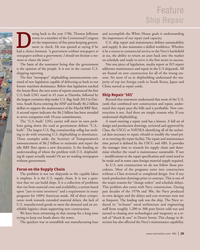 )
September 2025 - Marine News page: 29
)
September 2025 - Marine News page: 29jority of top tier foreign yards in South Korea, Japan and former maritime dominance. Before that legislation reached China started as repair yards. the Senate ? oor, the next series of reports announced the ? rst U.S.-built LNG vessel in 45 years at Hanwha, followed by Ship Repair ‘101’ the largest container
-
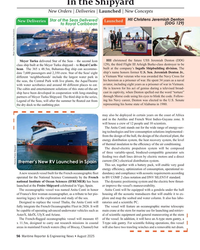 )
August 2025 - Maritime Reporter and Engineering News page: 56
)
August 2025 - Maritime Reporter and Engineering News page: 56his eyes to blink the code. Follow- partners of Meyer Turku Shipyard. The third ship in the series, ing his Navy career, Denton was elected to the U.S. Senate Legend of the Seas, will after the summer be ? oated out from representing his home state of Alabama in 1980. the dry dock to the out? tting pier
-
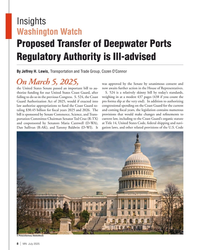 )
July 2025 - Marine News page: 8
)
July 2025 - Marine News page: 8Ports Regulatory Authority is Ill-advised By Jeffrey H. Lewis, Transportation and Trade Group, Cozen O’Connor On March 5, 2025, was approved by the Senate by unanimous consent and the United States Senate passed an important bill to au- now awaits further action in the House of Representatives. thorize
-
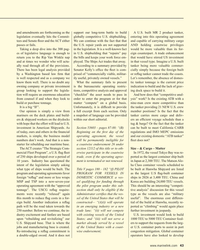 )
June 2025 - Maritime Reporter and Engineering News page: 43
)
June 2025 - Maritime Reporter and Engineering News page: 43MR 2 product tanker, legislation eventually hits the Commit- globally competitive U.S. shipbuilding. entering into this operating agreement tees and Senate ? oor and the ACT either We can continue with the fact that that and capable of carrying military cargo passes or fails. the U.S. repair yards
-
![MR Jun-25#42 .pdf]. U.S. Senate. The initial “Act” was](https://images.marinelink.com/images/magazines/w200h250c/MaritimeReporter-202506-page44.png) )
June 2025 - Maritime Reporter and Engineering News page: 42
)
June 2025 - Maritime Reporter and Engineering News page: 42ductivity in 1976 [https://www.gao.gov/ America Act (hereafter the ACT) in the for nearly 65 years we have overlooked assets/b-118779-095788.pdf]. U.S. Senate. The initial “Act” was ? rst how Japan ? rst got ahead of us or the introduced in December 2024. The re- fact that Korea took the lead not soon
-
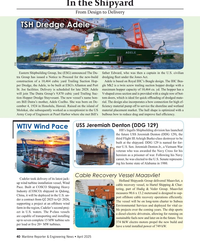 )
April 2025 - Maritime Reporter and Engineering News page: 40
)
April 2025 - Maritime Reporter and Engineering News page: 40Jr., a Vietnam War veteran who was awarded the Navy Cross for his heroism as a prisoner of war. Following his Navy career, he was elected to the U.S. Senate represent- HII ing his home state of Alabama in 1980. Cadeler Cable Recovery Vessel Maasvliet Cadeler took delivery of its latest jack- Holland Shipyards
-
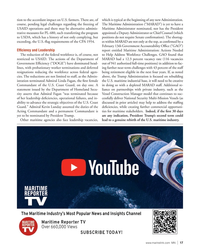 )
March 2025 - Marine News page: 17
)
March 2025 - Marine News page: 17the program appointed a Deputy Administrator or Chief Counsel (which to USDA, which has a history of not only complying, but positions do not require Senate con? rmation). The shortag- exceeding, the U.S.-? ag requirements of the CPA 1954. es within MARAD are not only at the top, as con? rmed by a
-
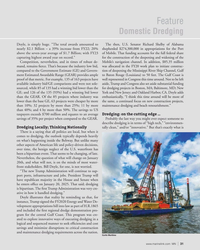 )
January 2025 - Marine News page: 31
)
January 2025 - Marine News page: 31. “The new Trump Administration will continue to sup- port ports, infrastructure and jobs. President Trump will have republican majority in the House and Senate when he enters of? ce on January 20, 2025. That said; dredging is bipartisan. The ? rst Trump Administration was very cre- ative in how it handled
-
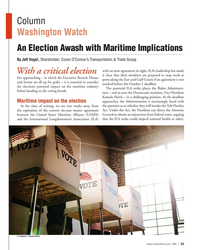 )
October 2024 - Marine News page: 23
)
October 2024 - Marine News page: 23are prepared to stop work at fast approaching – in which the Executive Branch, House ports along the East and Gulf Coasts if an agreement is not and Senate are all up for grabs – it is essential to consider reached before the October 1 deadline. the election’s potential impact on the maritime industry
-
 )
November 2022 - Marine News page: 26
)
November 2022 - Marine News page: 26and Congressional Representatives. Over the past year, both the current Commandant of the U.S. Coast Guard and the former Commandant testi? ed before the Senate Commerce Committee acknowledging the need for an- other heavy Great Lakes icebreaker. In addition, the Great Lakes Winter Commerce Act is included
-
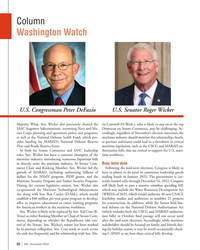 )
November 2022 - Marine News page: 20
)
November 2022 - Marine News page: 20also previously chaired the ria Cantwell (D-Wash.), who is likely to stay on as the top SASC Seapower Subcommittee, overseeing Navy and Ma- Democrat on Senate Commerce, may be challenging. Ac- rine Corps planning and operations policy and programs, cordingly, regardless of November’s election outcomes, the
-
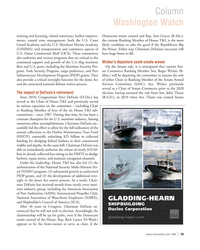 )
November 2022 - Marine News page: 19
)
November 2022 - Marine News page: 19departure could create waves continued support and growth of the U.S.-? ag maritime ? eet and U.S. ports, including the Maritime Security Pro- On the Senate side, it is anticipated that current Sen- gram, Tank Security Program, cargo preference, and Port ate Commerce Ranking Member Sen. Roger Wicker (R- Infrast
-
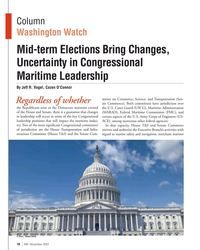 )
November 2022 - Marine News page: 18
)
November 2022 - Marine News page: 18have jurisdiction over the Republicans seize or the Democrats maintain control the U.S. Coast Guard (USCG), Maritime Administration of the House and Senate, there is a guarantee that changes (MARAD), Federal Maritime Commission (FMC), and in leadership will occur in some of the key Congressional certain
-
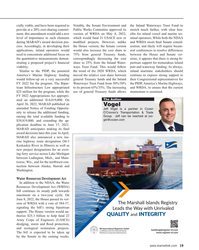 )
September 2022 - Maritime Reporter and Engineering News page: 19
)
September 2022 - Maritime Reporter and Engineering News page: 19cially viable, and have been required to Notably, the Senate Environment and the Inland Waterways Trust Fund to provide at a 20% cost-sharing commit- Public Works Committee approved its stretch much farther, with clear ben- ment, this amendment would add a new version of WRDA on May 4, 2022, e? ts
-
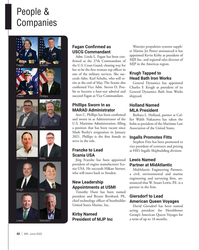 )
June 2022 - Marine News page: 42
)
June 2022 - Marine News page: 42? cer in Krugh Tapped to one of the military services. She suc- ceeds Adm. Karl Schultz, who will re- Head Bath Iron Works tire at the end of May. The Senate also General Dynamics has appointed con? rmed Vice Adm. Steven D. Pou- Charles F. Krugh as president of its lin to become a four-star admiral and
-
 )
May 2022 - Maritime Reporter and Engineering News page: 18
)
May 2022 - Maritime Reporter and Engineering News page: 18without success. The ? rst at- In January of 2023, legislation was introduced in the state tempt at a cooperative solution was led by The American Wa- senate and assembly to exempt commercial tug boats and tow terways Operators (AWO), in conjunction with the New York boats from the state’s Petroleum Business
-
 )
May 2022 - Marine Technology Reporter page: 60
)
May 2022 - Marine Technology Reporter page: 60,” Cropper said. “I send a special thank you to the dele- The newly funded ship, which has yet to be named, is the gates in the House of Representative and Senate from Alaska, ? fth in a series of 524.5-foot-long National Security Multi- California, Hawaii, Oregon and Washington in backing the Mission Vessels
-
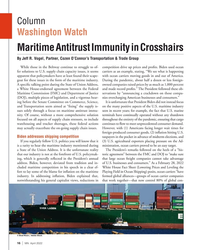 )
April 2022 - Marine News page: 16
)
April 2022 - Marine News page: 16crackdown on those compa- (DOJ), multiple pieces of legislation, and a vigorous hear- nies overcharging American businesses and consumers.” ing before the Senate Committee on Commerce, Science, It is unfortunate that President Biden did not instead focus and Transportation seem aimed at “? xing” the supply
-
 )
February 2022 - Maritime Reporter and Engineering News page: 37
)
February 2022 - Maritime Reporter and Engineering News page: 37to things that we need to do,” before the DDG(X)s are delivered. incorporate a helicopter hanger for two aircraft. 33 Flight Congress may agree. The Senate Armed Services Com- IIAs were built before production ended. The Arleigh mittee said in a report accompanying the National Defense Burke production
-
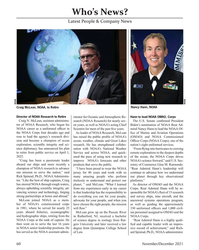 )
November 2021 - Marine Technology Reporter page: 60
)
November 2021 - Marine Technology Reporter page: 60to lead NOAA OMAO, Corps istrator for Oceanic and Atmospheric Re- Craig N. McLean, assistant administra- search (NOAA Research) for nearly sev- The U.S. Senate con? rmed President tor of NOAA Research, who began his en years, as well as NOAA’s acting Chief Biden’s nomination of NOAA Rear Ad- NOAA career
-
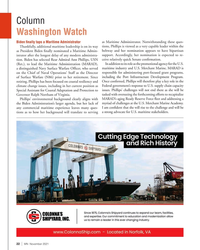 )
November 2021 - Marine News page: 22
)
November 2021 - Marine News page: 22modern administra- support. Accordingly, her nomination is expected to re- tion. Biden has selected Rear Admiral Ann Phillips, USN ceive relatively quick Senate con? rmation. (Ret.), to lead the Maritime Administration (MARAD), In addition to its role as the promotional agency for the U.S. a distinguished
-
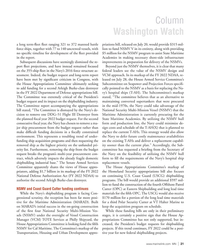 )
September 2021 - Marine News page: 21
)
September 2021 - Marine News page: 21, which adversely impacts the already fragile domestic form to ? ll the requirements of the Navy’s hospital ship shipbuilding industrial base.” The Senate Armed Services replacement vessels. Committee apparently shares the views of House appro- The House Appropriations Committee’s markup of priators
